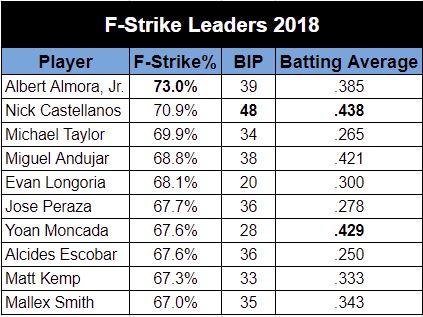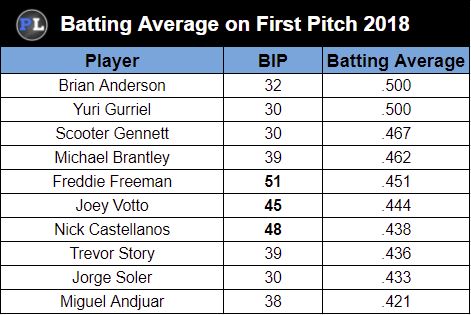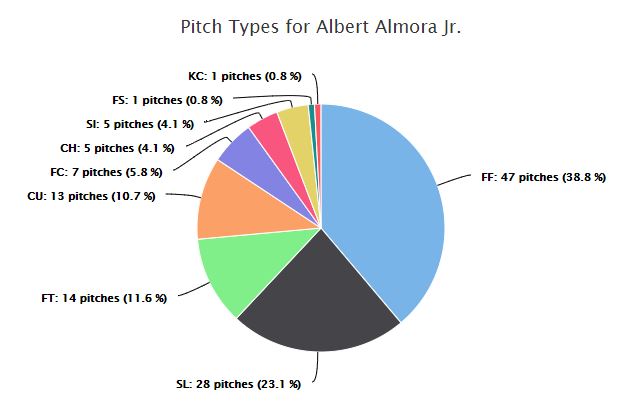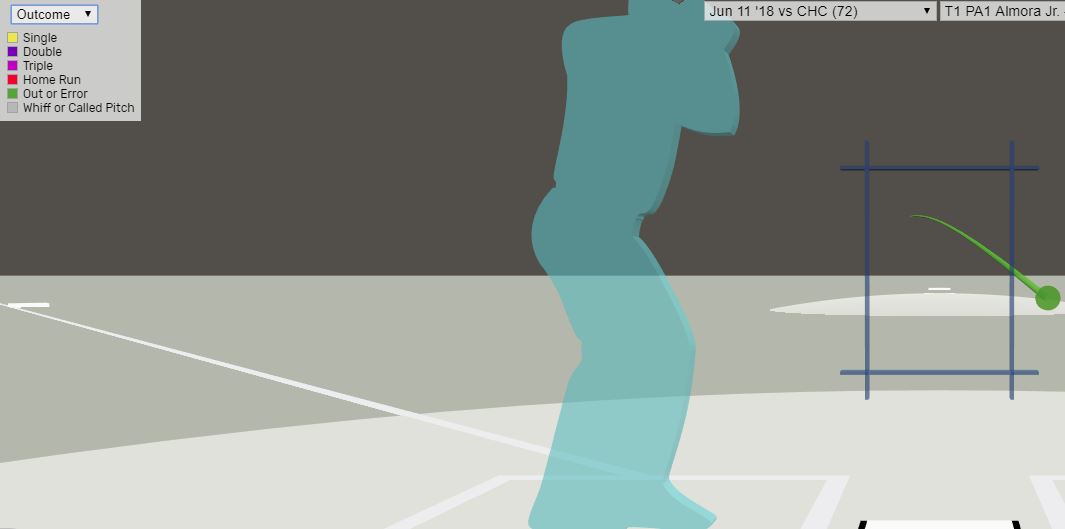(Photo by Dustin Bradford/Icon Sportswire)
The last three years Chicago Cubs‘ starting center fielder Albert Almora, Jr. has played in Major League Baseball, the average first-strike rate for hitters is about 61%. As we close in on the halfway point of the 2018 season, a whopping 73% of first pitches Almora sees are strikes.
When taking yearly average into consideration, Almora has at-bats totaling a little less than two seasons. While technically this is his third year, he appeared in just 47 games during his 2016 season, played 132 in 2017, and 58 so far in 2018. I mention this because we are going to be working with a small sample and most of the data I’ll be dealing with has yet to stabilize.
As the 2012 Major League Baseball Draft’s 6th overall pick, Almora’s defense and arm were considered his best assets while offensive skills are/were projected to be a little better than league average. As it stands right now, Almora is slashing .323/.374/.441 through 204 plate appearances with a 122 wRC+ and a 1.7 WAR; pretty great numbers. Almora also has an inflated BABIP of .384 which we can assume will drop a fair amount; his xBA is .248, or .075 points lower than his current average. He’s quick and athletic with 10 of his 19 groundballs in play ending up as infield singles. Additionally, Almora’s hard-hit rate is about 4% lower than his career average and about 8% lower than last season. His Barrel% is way down as well, with a good 2-3% deviation.
Whatever is happening thus far seems to be attributed to luck on Almora’s part. I say this because a high BABIP is usually legitimate if the hitter has a high average exit velocity (Almora’s is 85.8MPH) and a strong hard-hit percentage. It works somewhat the same for low BABIP; if a hitter has both previously mentioned attributes, they are going to be due for some significant improvement eventually.
Back to what is captivating about Almora’s 2018 season, is that he’s seen quite a bit more first-pitch strikes than any other (qualified) hitter. See Chart 1 below, which shows the current F-Strike% leaders along with the batting average the hitter produces when he puts the first pitch in play.

CHART 1
Leading the group in batting average is Detroit Tigers‘ Nick Castellanos, who doesn’t see quite as many first-pitch strikes but has swung away 131 times, putting 37% of those pitches in play. Of hitters who have faced at least 500 pitches, Castellanos is second to Atlanta Braves‘ Ozzie Albies; 131 and 133, respectively. Almora, on the other hand, ranks 30th in first-pitch swings but put the ball in play on 46% of those events.
Chart 2 gives us a look at the batting average leaders on first pitch BIP for hitters with at least 30 PAs under those conditions. No, Almora didn’t make the cut; he’s holding at 16th for now. If he’s able to put more balls in play, he could break into the top-10.

CHART 2
With all that said, Almora needs to take more cuts at the first pitch, plain and simple.
As mentioned before (see Chart 1), he’s being given a hittable first pitch in almost three out of every four plate appearances. Since 2016, 71 hitters saw league average or better when using F-Strike%; Almora has not had enough PAs to qualify. The highest running three-year average is Hernan Perez of the Milwaukee Brewers with 67.7%.
To further encourage Almora to take more first-pitch swings (I must mention that those swings be regulated to the zone), let’s talk about how he’s dealt with the initial delivery through his short career. His first-pitch OPS is .931 with 10 doubles, a triple, and three home runs. In 2018, his OPS on the first pitch is .895 with just four extra-base hits thus far. Is there a platoon advantage? No, because over 64% of pitchers he faces are right-handed and his career OPS against them is 70 points lower than against left-handed pitching. The same goes for 2018, albeit with a nearly 200 point disparity and a 70% split favoring righties.
So what is Almora getting on those first-pitch strikes? Mainly four-seam fastballs and sliders, which we will quantify and scale per 100 pitches using Pitch Info from Fangraphs. Almora is currently 6th in MLB with a wFA/100 of 2.98 (league average is around 0) and 93rd with a wSL/100 of -0.40, the latter actually being a bit above the league average of -0.58. Again, an advantage Almora should be cashing in on with early swings.

CHART 3
Now, that aggressive first-pitch approach doesn’t always lend itself to success. Take last night’s game against the Milwaukee Brewers. The graphic below shows the first pitch of the game and Almora taking a cut which resulted in an in-play out.

*courtesy of Baseball Savant
Here is the caveat; Almora has chased a lot of pitches this year. He ranks 21st in the league in highest O-Swing% and 88th in highest O-Contact%. Encouraging him to be more aggressive at the plate is going to necessitate a keener eye; the two cannot be mutually exclusive. Conversely, Almora is currently 41st in Z-Swing% and 51st in Z-Contact%.
Yet those numbers don’t seem skewed enough for teams to encourage their pitchers to throw strikes with regularity to Almora. His zone swings are above average (70.9%) as is his zone contact (89.4%). When contact is made in the zone, Almora is hitting .341, good for 55th out of hitters with at least 100 pitches hit in the strike zone. Furthermore, he’s swung at 10 out of zone first-pitches and has a .500 average, good for 4th overall of hitters with at least five PA OOZ swings on the first delivery.
What is it about Almora that pitchers feel the need to throw a strike to him more than any other hitter on the first pitch?
I would surmise that leadoff hitters, especially the first pitch of the game, typically get a pitch in the zone to start the game. But, that isn’t necessarily the case. I looked into this by taking all pitcher data from 2018, used a cut-off of 1000 pitches, and averaged out the number of starts as well as initial pitches in the zone to the leadoff hitter during the applicable portion of the first inning. I then took the average amount of starts (13) and the average amount of pitches in the zone (8) regardless of swing tendencies and found that 62% of first pitches in games end up as strikes which, if you recall, is in line with the overall first-pitch strike average of the last three seasons.
Almora is making himself rare company in 2018. He’s getting one of the highest rates of first-pitch strikes in the history of baseball, or at least for the first half of the season. Most of the other hitters getting that kind of treatment are low-quality hitters and that makes Almora’s situation that much more interesting. He’s already becoming one of the better hitters in baseball but, again, going back to the aforementioned BABIP issue, a lot of what is happening to Almora could be nothing more than luck. Perhaps being more aggressive on that first pitch, which he’s been successful against both in and out of the zone, can eliminate some of that luck thereby making him a more legitimate hitter than he already is.

Really interested in the potential of Jose Fernandez, of the Angels. Can he be the subject of a future “Going Deep”?
Let’s see more plate appearances, though. Stay tuned!
It’s not terribly surprising. In a deep lineup he is what is seen as the weakest link.
Maybe he should swing at more first strikes, but his approach has worked pretty good.
People will start pulling their hair out if he starts hitting into first pitch double plays or doesn’t square it up because he hasn’t seen a few pitches.
He has to be more respected than Heyward, Russell, Happ, and even Zobrist; .812 OPS
And you’re right about swinging early. That’s why I made it a point to mention I’m not suggesting he go up there hacking away.